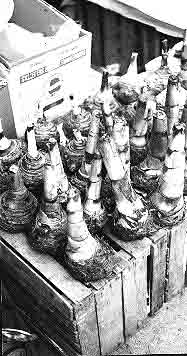 This thick, somewhat pulpy banana with squared edges is most delicious when it looks overripe, and is roasted as among a woodfire's embers; people often say that if you eat it raw you'll get gassy, but it's good that way, too; depending on your location it's variously known as plátano de bolsa, plátano pera, cuadrado or banana.
This thick, somewhat pulpy banana with squared edges is most delicious when it looks overripe, and is roasted as among a woodfire's embers; people often say that if you eat it raw you'll get gassy, but it's good that way, too; depending on your location it's variously known as plátano de bolsa, plátano pera, cuadrado or banana.One of the most astonishing discoveries Northerners make in Mexican mercados is that there is a veritable rainbow of types of banana. The bananas typically seen in US supermarkets usually is the relatively bland, uninspiring variety -- most planted worldwide because it travels well and doesn't get as splotchy as other kinds -- the yellow Cavendish. In much of the world's tropics such huge monocultures of Cavendishes have been planted. Large monocultures are by nature vulnerable to plague diseases, and Cavendish plantations are succumbing fast to the fugus Fusarium oxysporum. New cultivars are being sought to take their place, so the banana-buying scene is changing fast.
 Morada bananas in a tianguis market in Metepec, México State; copyright-free image courtesy of "Thelmadatter" made available through Wikimedia Commons.
Morada bananas in a tianguis market in Metepec, México State; copyright-free image courtesy of "Thelmadatter" made available through Wikimedia Commons.The multitude of banana varieties have all developed from a rather puny wild stock originally found in India, known to science as Musa paradisiaca, of the Banana Family.
Over the centuries, mankind's genetic manipulation of the banana plant has been so far-ranging that cultivated banana plants produce fruits -- bananas -- that, normally, contain no seeds. The next time you bite into a banana, notice the tiny, dark specks toward the fruit's center. These are aborted ovules, which would have become seeds if the plant's genes weren't so screwed up by humans.
 In Mexico City, selling big, somewhat waxy macho bananas best eaten fried, though they're also good eaten raw if you don't mind the gassiness; public domain image courtesy of "Syced" made available through Wikimedia Commons.
In Mexico City, selling big, somewhat waxy macho bananas best eaten fried, though they're also good eaten raw if you don't mind the gassiness; public domain image courtesy of "Syced" made available through Wikimedia Commons.Names for the various banana races change from region to region in Mexico. Here is a list of some of the best-known varieties found in mercados, using names popular in central Mexico:
- Dominito: Moist, sweet, with a fruity flavor vaguely suggesting mango.
- Largo: Lots of peel, rather bland taste.
- Manila: Moist and fruity flavored.
- Manzana: Purple, thin-peeled, flesh dry, with sweet but slightly musky flavor.
- Morado chico: Small purple banana.
- Morado grande: Large purple banana.
- Plátano de bolsa: A pulpy, slightly sour variety often roasted among embers of wood fires.
- Plátano macho: Very large, moist, fibrous, bland, used for frying.
- Tabasco: A variety often found in US supermarkets.